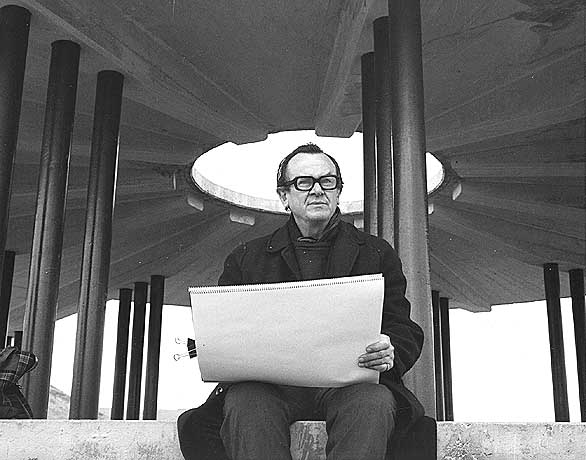
Artist Hereward Lester Cooke at Grand Coulee Dam, Washington
Hereward Lester Cooke was born in Princeton, New Jersey in 1916. He studied at Oxford University, Art Students League (under George Bridgman), Yale University School of Fine Art, and Princeton University Graduate School where he received his Ph.D. Cooke is better known for his work in art history than for his painting, having written several texts including Painting Lessons from the Great Masters in 1967. He was the Curator of Painting at the National Gallery of Art from 1961-1973, and before that he was a National Gallery aide and acting assistant director, beginning in 1956. Part of his duties as curator included heading the Expert Opinions Section of the National Gallery, where owners of artworks could come have their art appraised or otherwise identified. He was a well known authority on fakes and forgeries, and was called the "Sherlock Holmes of the Art World" for his work in solving art mysteries of attribution. As a curator, Cooke was very influential in the government sponsored art programs, helping to select artists for the Environmental Protection Agency art program, and serving as art advisor to NASA for ten years. He organized the National Gallery exhibit of NASA art in 1969. Cooke's successes may have been more visible in art history, but he was also well regarded as an artist. Not only was he appointed director of the American pavilion at the Venice Biannual International Art Exhibition, but he was also artist in residence at Princeton for four years and he won the Prix de Rome and a Fulbright fellowship. In 1940 he won the American Beaux Arts prize for murals.
The Bureau of Reclamation painting collection includes two of Cooke's drawings. Both are of the Grand Coulee Dam project, one entitled Street Scene Grand Coulee and the other Construction Tower. Both are done in sepia ink, pen, and pencil, and are sketchy in nature, using repetitive strokes to define each object. This repetition gives a sense of motion and animation to each object, as the outlines are not precisely defined. The smudges in Construction Tower further animate the sketch. The use of the diagonal road in the street scene leads the viewer's eyes through the painting and again reinforces the feeling of movement. In Street Scene Grand Coulee, the dominant movement is vertical, with all of the signs spiking upward, piercing the white unmarked sky. The multitude of signs, combined with the sketchy nature of the drawing give it energy and a sense of anticipation or excitement. Likewise, in Construction Tower there is a sense of energy due in part to the subject matter--many men constructing a massive structure, and in part from the artist's execution of the drawing. In his earlier works, often of the old fish wharves in Washington, D.C., the lines were much tighter, with every feature or wash delineated. These two drawings, dating to 1970, come from his later period.
Return to Artists and Images